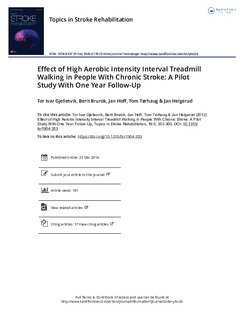| dc.contributor.author | Gjellesvik, T.I. | |
| dc.contributor.author | Brurok, B. | |
| dc.contributor.author | Hoff, J. | |
| dc.contributor.author | Torhaug, T. | |
| dc.contributor.author | Helgerud, J. | |
| dc.date.accessioned | 2018-04-17T12:14:53Z | |
| dc.date.available | 2018-04-17T12:14:53Z | |
| dc.date.issued | 2012 | |
| dc.identifier.citation | Gjellesvik, T. I., Brurok, B., Hoff, J., Torhaug, T., & Helgerud, J. (2012). Effect of high aerobic intensity interval treadmill walking in people with chronic stroke: a pilot study with one year follow-up. Top Stroke Rehabil, 19(4), 353-360. | nb_NO |
| dc.identifier.uri | http://hdl.handle.net/11250/2494493 | |
| dc.description.abstract | Objective: To determine the physiological and functional responses from high aerobic intensity treadmill walking in 4 x 4-minute intervals in people with chronic stroke and to evaluate the feasibility of this mode of training.
Method: This was a baseline control trial with 1 year follow-up in an outpatient rehabilitation setting at a university hospital. Eight people with chronic stroke participated in and completed the study. Their mean age was 48.9 (± 10.6) years. We tested uphill treadmill walking in 4 x 4-minute work periods at an intensity between 85% and 95% of peak heart rate from initial maximal treadmill testing. There were 3-minute active breaks between the intervals. The main outcome measures were peak oxygen uptake (VO2peak) and walking economy (Cw). Overall compliance and adverse events determine the feasibility.
Results: VO2peak increased from 2.32 (± 0.44) to 2.60 (± 0.55) L • min–1 post training (P = .003). Walking economy (Cw) improved from 1.12 (± 0.15) to 1.04 (± 0.18) L • min–1 (P = .043). At 1 year follow-up, VO2peak was 2.59 (±0.58) L • min –1 and was not significantly different from posttraining measurement (P = 1.00). Cw was 1.19 (± 0.15) L • min–1 at 1 year follow-up and thus was worse than post training (P = .023). Functional improvements were found in the 6-minute walk test (6MWT) (P = .020), 10-meter walk test (10MWT) (P = .032), and Timed Up and Go test (TUG) (P = .002) at post tests.
Conclusions: High aerobic intensity interval treadmill walking significantly increased VO2peak and improved Cw in these subjects. The training was feasible and may have important implications for cardiovascular health and future rehabilitation programs in this population. | nb_NO |
| dc.publisher | Topics in Stroke Rehabilitation | nb_NO |
| dc.subject | function | nb_NO |
| dc.subject | high intensity | nb_NO |
| dc.subject | stroke | nb_NO |
| dc.subject | treadmill | nb_NO |
| dc.title | Effect of high aerobic intensity interval treadmill walking in people with chronic stroke: a pilot study with one year follow-up | nb_NO |
| dc.type | Journal article | nb_NO |
| dc.source.pagenumber | 353-360 | nb_NO |
| dc.source.volume | 19 | nb_NO |
| dc.source.journal | Topics in Stroke Rehabilitation | nb_NO |
| dc.source.issue | 4 | nb_NO |
| dc.identifier.doi | 10.1310/tsr1904-353 | |
| dc.description.localcode | måsjekkes | |
